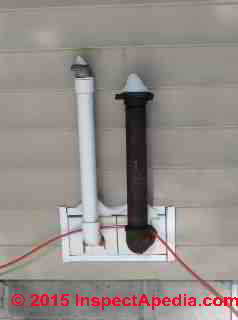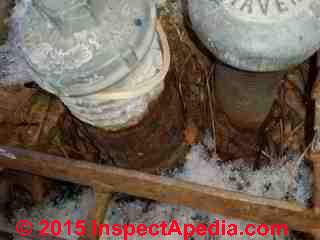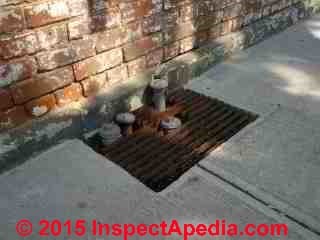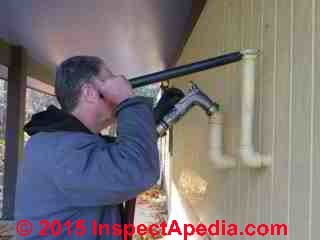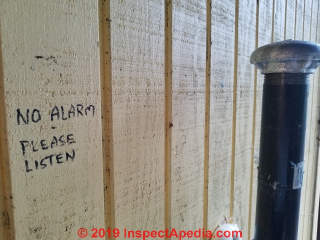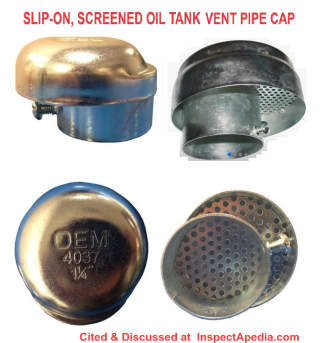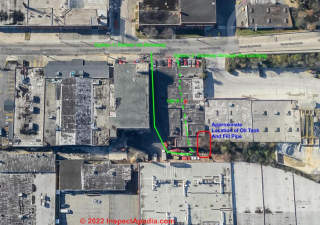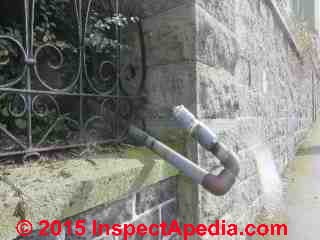 Oil Tank Fill & Vent Piping Installation & Inspection
Oil Tank Fill & Vent Piping Installation & Inspection
- POST a QUESTION or COMMENT about oil fill & vent piping location, diameter, length, routing, connections, leaks, & troubleshooting.
Our oil stroage tank fill & vent piping installation & inspection guide starts here with a simple piping checklist.
Inspection for Above Ground Heating Oil Storage Tanks (ASTs) includes a careful check of the oil tank fill and vent piping for size, routing, and other concerns that, if not handled properly, can increase the risk of oil spills or in the worst case, a catastropic oil tank leak from excessive pressure during tank fill-up.
This heating oil piping article series gives advice and example photos for the installation, inspection, & leak troubleshooting of oil tank fill & vent piping for both buried and above ground oil storage tanks.
InspectAPedia tolerates no conflicts of interest. We have no relationship with advertisers, products, or services discussed at this website.
- Daniel Friedman, Publisher/Editor/Author - See WHO ARE WE?
Heating Oil Fill & Vent Piping installation, inspection, troubleshooting
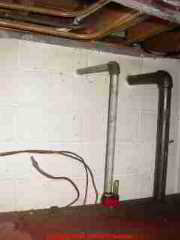 Here are some important indicators of tank condition and requirements for oil tank fill and vent pipe size, location, termination, and routing that any home owner or home inspector can examine when an oil storage tank
is visible and accessible inside or at a building.
Here are some important indicators of tank condition and requirements for oil tank fill and vent pipe size, location, termination, and routing that any home owner or home inspector can examine when an oil storage tank
is visible and accessible inside or at a building.
Article Series Contents
- OIL TANK FILL & VENT PIPING INSPECTION CHECKLIST - you are on this page
- OIL TANK FILL & VENT PIPING MATERIALS
- OIL TANK FILL & VENT PIPING SIZE REQUIREMENTS
- OIL TANK FILL & VENT PIPING OUTDOOR TERMINATION & CLEARANCES
- OIL TANK FILL & VENT PIPING BENDS & ELBOWS
- OIL PIPING for DUAL OIL TANK INSTALLATIONS
[Click to enlarge any image]
Oil Tank Piping Inspection Checklist
- Are both oil storage tank's fill and vent pipes properly sized?
with the right size piping (1 1/2" on older systems, 2" diameter piping by current standards). A too small oil storage tank vent (above right) subjects the tank to extra pressure during fill-up and may contribute to or even cause a leak or oil spill.
In the photo, a 1 1/2" vent line is installed. Some older oil tank installations use 1 1/4" diameter vent piping, considered undersized if the oil tank is larger than 660 gallons in capacity.
In most jurisdictions your oil company recommends going to 2" for vent pipe diameter, and most new oil tank installations use a two-inch diameter vent pipe.
We've seen vent piping as small as one inch on oil tanks. (photo below).
Why is undersized venting on an oil tank a worry? During fill, fuel is delivered at an average rate of 60 or even 70 gallons per minute.
Improper or blocked oil tank air exit venting can place excessive stress on tank seams and piping. For older oil tank installations where the tank may suffer from hidden, internal rust and corrosion, the risk of an expensive oil spill from a leaky or burst oil tank is still greater.
See OIL TANK PRESSURE for a detailed explanation.

- If the oil tank is indoors,
does the tank vent extend to outside? - Are the outdoor fill and vent pipes readily accessible
to the oil delivery driver. These can be no further than 100 ft. from an accessible road or drive and must be at an accessible height.
Below, in our photograph, an oil fill pipe at a property in Dunedin, New Zealand (South Island) doubles back on itself to give the oil delivery driver a fighting chance at filling an oil tank that is uphill from the point of fill. To me [DF] this is a rather ugly installation that seems likely to lead to a spill.
- Is the oil tank vent line properly capped
with a screened weather-resistant cap to prevent water entry or clogging by mud or insects?
- Is the oil tank piping tight,
leak-free, and does it drain freely into the tank? Has the piping been equipped with a whistle to signal the delivery person when the tank is full?
- Are all tank plugs and piping tightly in place?
Openings in the oil storage tank should be closed with proper fittings.
- Has black or galvanized iron piping been used
for oil tank filler and vent lines? Proper and best piping materials for the fill and vent pipe include black iron pipe or galvanized iron pipe;
Cast iron fittings shall not be used. - Has plastic or PVC piping been used
for the oil tank vent or fill piping?
Plastic oil storage tank fill or vent piping (above left) may come apart at the seams during a fill up. Some plastic lines can shatter or break in extremely cold weather.
[Some communities may permit plastic vent piping - Ed.]
See details on oil fill and vent piping materials at
at OIL TANK LEAK & ABANDONMENT REGULATIONS - Are the oil tank fill & vent pipes damaged or badly rusted
so as to risk failure or leakage (photo, above right showing exfoliating rust and swelling of the oil tank piping).
- Are oil storage tank fill and/or vent pipes close-to or below ground well-protected
from water or melting snow? If a cap is loose, can water enter the oil system?
The photos above show the oil tank fill piping is unprotected and very close to the ground, a risk for water entry from melting, accumulated snow if a cap is loose or its gasket defective.
See OIL FILL / VENT PIPE RUST-CAUSED LEAKS for details.
- Is there a visible, accessible oil tank vent pipe?
Is the oil tank vent pipe missing, blocked, or removed?
At BURIED OIL TANK (UST) GUIDE, we describe a catastrophic indoor oil leak when (apparently) a buried oil tank burst and then leaked a high volume of heating oil underground, under the building foundation, and up through the basement floor slab where it filled the sump pit, chimney cleanout base, and then entered the basement floor (heating oil leak photo above).
A missing or buried or blocked tank vent may have had a role in this oil tank failure and spill.
- Is the tank vent next to or close to the oil filler pipe
so that the delivery person can listen to the vent alarm (some call this the oil tank vent whistle) and determine when the tank is full?
And in the case of no alarm, for other less attentive oil truck drivers who were over-filling the oil tank, we added a "NO ALARM - PLEASE LISTEN" reminder.
Why is the driver listening at the oil tank vent pipe?
There are several reasons:
The oil delivery driver wants to be sure that oil is flowing into an intact oil tank not into an empty room where the oil tank was removed or where the tank has fallen apart - avoiding an oil spill catastrophe.
Also
He wants to know when the oil tank has been filled to a proper level, especially in the event that the oil tank does not have a working vent alarm.
What is the heating oil delivery driver listening for?
What will he hear?
Listening at the tank vent, the oil delivery driver will hear an echo of the filler nozzle being connected to the filler pipe, and he will hear the sound of oil rushing into the hollow oil tank interior. He'll also hear air rushing out of the tank vent as oil entering the tank displaces air.
He will also hear a "slap" sound if rising oil in the tank hits the bottom of the vent alarm (even if the vent alarm is not working) or a slap when the oil hits the bottom of the tank vent if no vent alarm is working.
An oil delivery driver explained to me that when he hears that tank-full slap he always steps back quickly from the vent out of an inbred concern for being shot in the ear with heating oil - though that actually never happens.
Special thanks to Bottini Oil, Poughkeepsie, New York, for these helpful tips from a savvy oil delivery driver (December 2017).
Watch out: heating oil tanks that are not equipped with a vent alarm are at risk of being over-filled or over-pressurized, damaged, or even burst from an oil delivery.
- Is there a working vent alarm or tank whistle?
If not, there is a risk of oil storage tank over-filling and leaks or even tank damage. The blue vent alarm shown here is a King Fill™ oil storage tank vent alarm.
The vent alarm prevents over filling and is recommended for both underground and above ground tanks. It should be mounted at the top of the tank at the vent pipe opening. (Naturally inspectors cannot see this component on buried tanks.)
You can't see most of this vent alarm when it's installed as the threaded portion and copper down-tube extend down into the oil tank; the oil tank vent pipe is connected to the tank vent alarm top; as the oil tank is being filled, air pushed out of the tank by incoming oil causes the alarm to make a whistling sound.
When oil reaches nearly the top of the tank, it stops air from passing out through the brass down-tube and thus stops the whistle while the oil level is an inch or two below the very top of the oil tank.
Also see Durst and Scully for more oil tank vent alarm devices
See details
at OIL TANK GAUGE & VENT ALARM INSTALL / REPLACE
See OIL TANK SPILL CLEANUP / PREVENTION for additional over-fill prevention and leak or spill detection devices
Below: when a tank alarm was added (along with a new oil storage tank), we amended the message to the oil delivery driver accordingly.
- Is the oil tank gauge installed and tight.
Loose or broken oil tank gauges can cause spills during tank fill operations.
See OIL TANK GAUGE LEAK REPAIR for details. - Is there evidence of seepage, leakage, spills
around the fill or vent piping or on the ground around the oil tank or filler fitting?
See OIL TANK FILL / VENT PIPE LEAK REPAIRS for details. - Is there a proper vent cap and screen atop the oil tank vent pipe?
See the illustration below.
Approved Oil Tank Piping Materials
Now moved
Oil Tank Fill & Vent Piping Size / Diameter Requirements
Fill and Vent Piping for Duplex Heating Oil Storage Tanks
Now found at OIL TANK PIPING for DUAL OIL TANK INSTALLATIONS
Oil Fill & Vent Pipe Termination: Outdoors, Clearance Distances
Moved to OIL TANK FILL & VENT PIPING OUTDOOR TERMINATION & CLEARANCES
Oil Tank Piping Bends & Elbows
...
Reader Comments, Questions & Answers About The Article Above
Below you will find questions and answers previously posted on this page at its page bottom reader comment box.
Reader Q&A - also see RECOMMENDED ARTICLES & FAQs
On 2023-03-19 by InspectApedia Editor (mod) - can't fill oil tank - vent alarm or gauge stopped working
@Ed,
Thanks, that's an interesting oil tank gauge troubleshooting problem.
It would help if you'd post a photo of your tank gauge so that I can see the type.
Most oil tank gauges use a float attached to a hinged rod in the oil tank. They're not precisely accurate, but when a gauge is way-off I suspect that the hinged, floating rod is stuck or, less-likely, bent.
If your gauge is one that shows the tank level with a vertical wire carrying an indicator disc on the wire top, often we can, without removing the gauge from the tank, fix a stuck gauge by un-screwing the plastic cover over the floating indicator and then pushing it gently down or lifting it gently up a couple of times to see if it will begin to move freely.
On 2023-03-17 by Ed
My indoor oil tank gauge was at1/8”,and I ordered 150 gallons of oil. The driver could only put in around 60 gallons, because the vent stopped whistling. The level gauge was now slightly under 1/2 full for my 275 gallon tank.
Could this be a gusher or air vent problem, since both seem to be someway working ?
Any ideas or help would be appreciated. Thanks
On 2023-02-11 by InspectApedia Publisher (mod) - vibration noise when filling oil tank
@jack,
You certainly ask an important question but not one that I can answer beyond wild speculation when we have simply a brief text.
Could you please inspect your oil tank and see the point from which the leak is occurring and post a photo of that for us to examine.
You should also let your oil company know that the tank is leaking. You should know that depending on where you live oil tank spills and leaks may be required to be reported to your department of environmental conservation within 24 hours.
If we are in luck, The leak will be at a fitting that can be tightened or resealed.
On 2023-02-11 by jack
at or near the end of having my 275 gallon tank filled i heard a loud vibration noise. tank started dripping when truck left! WHAT CAUSED LEAK?
On 2022-12-29 by InspectApedia Publisher (mod) - clearance distance oil tank vent to power exhaust vent outlet
@Nick,
Thanks that's an interesting question; I have not found a model code that specifies a clearance distance between an oil tank fill/vent pipe and a power vent exhaust from heating equipment.
If as we are forced to guess, your power vent is an exhaust-only system then there's no concern with an oil fume intake - even during oil tank fill-up.
On 2022-12-29 by Nick
How fat dose the fill and vent need to be from a power venter
On 2022-12-14 by InspectApedia (Editor) - can you fill an oil tank by running a hose through a large building
@Ali,
That federal regulation surely does not apply to building heating oil tank filling procedures where it is entirely common for the driver to stand next to the oil fill and vent pipe during filling - as you will see in photographs on this page.
Here is the proper document title
Title 49 - Transportation
Subtitle B - Other Regulations Relating to Transportation
Chapter I - Pipeline and Hazardous Materials Safety Administration, Department of
Transportation
Subchapter C - Hazardous Materials Regulations
Part 177 - Carriage by Public Highway
Subpart B - Loading and Unloading
Authority: 49 U.S.C. 5101-5128; sec. 112 of Pub. L. 103-311, 108 Stat. 1673, 1676 (1994); sec. 32509 of Pub. L. 112-141, 126
Stat. 405, 805 (2012); 49 CFR 1.81 and 1.97.
§ 177.837 Class 3 materials.
On 2022-12-14 by Ali
@InspectApedia ,
Thank you for the quick response. I don't have a particular oil company in mind at this point, this is more at the proof of concept stage.
I did stumble upon
§ 177.837 Class 3 materials [PDF] Copy at InspectApedia.com at
https://inspectapedia.com/oiltanks/49-CFR-177.837-12-12-2022.pdf
- original source: https://www.ecfr.gov/current/title-49/subtitle-B/chapter-I/subchapter-C/part-177/subpart-B/section-177.837
where it says all the way at the bottom that the person filling the tank needs to be 150 ft or less away from the delivery truck which would seem difficult/impossible given the size of the building unless they went into the back.
Unloading combustible liquids.
For a cargo tank unloading a material meeting the definition for combustible liquid in § 173.150(f) of this subchapter, the qualified person attending the unloading operation must remain within 45.72 meters (150 feet) of the cargo tank and 7.62 meters (25 feet) of the delivery hose and must observe both the cargo tank and the receiving container at least once every five minutes during unloading operations that take more than five minutes to complete.
On 2022-12-13 by InspectApedia (mod) - can you fill an oil tank by running a hose through a large building
@Ali,
There are few oil companies who use an oil delivery truck with a 150' long hose, although that length is possible.
There's an extra cost to install a large hose from on the oil delivery truck and a lot more trouble to unwind and pull the hose over that distance and to rewind.
So more likely the oil company delivery truck wants to drive close to your oil tank.
Have you called the oil company who delivers to that building to ask how they access tank?
On 2022-12-13 by Ali
I purchased a commercial building in an industrial zone in Washington, DC and there is an oil tank behind the building in the rear. The oil tank is behind a brick wall, with a visible exterior fill-pipe visible outside that wall. The rear of the building is approximately 150 ft from the main road.
There are only three ways a driver can access the fill pipe. 1) By driving their vehicle through the driveway on the side of the building in which case they could drive very close to the fill pipe in the rear (they could also run a hose through the driveway into the rear), or by running a hose through the 150 ft building itself from the main road in the front and out the loading dock in the back.
My question is, is it common for a driver to fill an oil tank by running a hose through such a large building itself?
To me it would seem unsafe to run a hose through the building itself but I'm wondering if there is some regulation, code, manual, best practice that I can point to that says that. It would be very helpful if I could find such a regulation/code/manual. I've attached an image.
On 2022-11-26 by InspectApedia (Editor) - clearance around oil tank installed in the basement
@Ron,
Yes, please see details at
AST INDOOR - CLEARANCE DISTANCES - above ground indoor oil tank clearance distances
On 2022-11-26 by Ron
Is there a required clearance around a 330 gallon oil tank installed in the basement? For example next to a wooden work bench?
On 2021-08-04 by inspectapedia.com.moderator - buried oil tank pipe connections can be at either end or in the middle
@George,
Buried oil tank pipe connections can be at either end or in the middle;
Worse, where the fill and vent pipes are brought to the surface are not always even over the tank; for example often they're brought up close to a building so as to be out of the way and less likely to be run over by a mower.
The top of the tank won't be that deep; choices to mark off a safe distance from the tank include
- note the tank capacity and thus from any vendor's table of tank shapes and sizes, estimate its length and mark off a circle (since we are not sure of the tank's orientation) that's a safe distance away
- use a metal detector to follow the pipes, find the tank, mark its location and extent
- dig down at the exposed pipes to see if you find the tank top or else follow the pipes to the tank, and then dig enough to find its ends to mark off a safe clearance distance
OIL TANK, BURIED, FINDING
On 2021-08-04 by George
I have a 1000 gallon in ground oil tank and need to do some trenching near it for a gas line (the oil tank will be removed next spring.) My memory from 40 years ago is that the fill and vent pipes sticking out of the ground are near one end of the tank rather than in the middle.
I can find info online that the tank is likely to be 130" long, but can't find anything about where the inlet would be on the tank - center or near an end. Can you speculate based on your experience, or point me to a specs page that would show the tank details?
On 2021-05-23 by danjoefriedman (mod) - Concrete can be placed around the fill and vent pipes for your buried oil tank
@Linda White,
Concrete can be placed around the fill and vent pipes for your buried oil tank.
Keep in mind that IF the tank is old and is going to need to be replaced soon, it might make sense to have it opened, emptied, cleaned and filled in before the sidewalk goes in just because it'll be easier and a bit less costly.
So you might want it tested for leaks.
On 2021-05-23 by Linda White
I have an ingrown oil tank with both a fill pipe & tall air pipe in ground properly separated for years now, since built.
My question:,they are replacing the concrete walkway on side of my home, can the concrete still surround this pipe or do they have to put something around the pipe? The pipe is solid & intact.
On 2013-03-06 by Greg - fuel loss through evaporation?
On my outdoor oil tank the fuel gage had broken off leaving about a 1/2 hole straight down to the oil.
Is it possible that I was getting fuel loss from evaporation and if so would it be significant? Fortunately the vent cap was hovered over it so I don't think any water was getting in there but who knows.
On 2013-02-11 by Sean - longest horizontal fill/vent run allowed?
I am preparing to install a new tank. What is the longest horizontal fill/vent run allowed? is 10 feet from tank to fill nozzle going to allow proper flow?
...
Continue reading at OIL TANK FILL & VENT PIPING MATERIALS or select a topic from the closely-related articles below, or see the complete ARTICLE INDEX.
Or see OIL FILL & VENT PIPING FAQs - questions and answers posted originally on this page.
Or see these
Recommended Articles
- OIL TANK CODES & STANDARDS - home
- OIL TANK GAUGE & VENT ALARM INSTALL / REPLACE
- OIL TANK INSPECTION & TROUBLESHOOTING - home
- OIL TANK PIPING & PIPING DEFECTS - home
- DUAL OIL TANKS - PIPING
- OIL LINE PIPING LEAK CAUSES
- OIL LINE VACUUM & PRESSURE TESTS
- OIL SUPPLY & RETURN LINE CONTROLS & VALVES
- OIL TANK FILL & VENT PIPING INSPECTION CHECKLIST - home
- OIL TANK FILL & VENT PIPING BENDS & ELBOWS
- OIL TANK FILL & VENT PIPING DEFECTS
- OIL TANK FILL & VENT PIPING MATERIALS
- OIL TANK FILL & VENT PIPING SIZE REQUIREMENTS
- OIL TANK FILL & VENT PIPING OUTDOOR TERMINATION & CLEARANCES
- OIL TANK FILL / VENT PIPE LEAK REPAIRS
- OIL TANK LEAKS & SMELLS - home
- OIL TANK PRESSURE
- OIL TANK SPILL CLEANUP / PREVENTION
Suggested citation for this web page
OIL TANK FILL & VENT PIPING INSPECTION CHECKLIST at InspectApedia.com - online encyclopedia of building & environmental inspection, testing, diagnosis, repair, & problem prevention advice.
Or see this
INDEX to RELATED ARTICLES: ARTICLE INDEX to HEATING OIL, OIL BURNERS, OIL FIRED HEATERS, OIL TANKS
Or use the SEARCH BOX found below to Ask a Question or Search InspectApedia
Ask a Question or Search InspectApedia
Try the search box just below, or if you prefer, post a question or comment in the Comments box below and we will respond promptly.
Search the InspectApedia website
Note: appearance of your Comment below may be delayed: if your comment contains an image, photograph, web link, or text that looks to the software as if it might be a web link, your posting will appear after it has been approved by a moderator. Apologies for the delay.
Only one image can be added per comment but you can post as many comments, and therefore images, as you like.
You will not receive a notification when a response to your question has been posted.
Please bookmark this page to make it easy for you to check back for our response.
IF above you see "Comment Form is loading comments..." then COMMENT BOX - countable.ca / bawkbox.com IS NOT WORKING.
In any case you are welcome to send an email directly to us at InspectApedia.com at editor@inspectApedia.com
We'll reply to you directly. Please help us help you by noting, in your email, the URL of the InspectApedia page where you wanted to comment.
Citations & References
In addition to any citations in the article above, a full list is available on request.
- Mark Cramer Inspection Services Mark Cramer, Tampa Florida, Mr. Cramer is a past president of ASHI, the American Society of Home Inspectors and is a Florida home inspector and home inspection educator. Mr. Cramer serves on the ASHI Home Inspection Standards. Contact Mark Cramer at: 727-595-4211 mark@BestTampaInspector.com
- John Cranor [Website: /www.house-whisperer.com ] is an ASHI member and a home inspector (The House Whisperer) is located in Glen Allen, VA 23060. He is also a contributor to InspectApedia.com in several technical areas such as plumbing and appliances (dryer vents). Contact Mr. Cranor at 804-873-8534 or by Email: johncranor@verizon.net
- Arlene Puentes [Website: www.octoberhome.com ] , an ASHI member and a licensed home inspector in Kingston, NY, and has served on ASHI national committees as well as HVASHI Chapter President. Ms. Puentes can be contacted at ap@octoberhome.com
- [1] Audels OIL BURNER GUIDE, Installing, Servicing, Repairing [Free online copy] Frank D. Graham, Theo. Audel & Co., New York 1946, 1947, 1955 (out of print, copies occasionally available from antique book dealers and on EBay).
- [12] Fuel oil safety valves, Webster Fuel Pumps & Valves, 219 Hahn Road Frankfort, Ky. 40601, Tel: (800) 766-1233 Email: czahalka@cctoolinc.com (Curtis Zahalka Sales Mgr/Mkt /Cust Service/Tech Support/Webmaster ) web search 10/12/2011 original source http://www.websterfuelpumps.com/pdffiles/osv1.pdf
- [13] Webster Service Technicians' Handbook, Webster Fuel Pumps & Valves, 219 Hahn Road Frankfort, Ky. 40601, Tel: (800) 766-1233
- [16] Tigerloop: oil line de-aerator devices, Westwood Products Inc., 330 William St., PO Box 610, South River, NJ 08882-0610 - (732) 651-7700
- Dave Ferris - M&S Environmental Systems, Dutchess County, New York. Mr. Ferris was an
HVAC expert.
Personal communication to DJF 1987.
Remove the firematic or fusible oil supply line valve on return oil-line side - in case of fire if this one closes first the pump continues to run, blows its seal, and sprays oil all over the fire.
Proper installation is to have a fusible link valve only on the supply side, and to install a check valve on the return line to prevent back-siphonage from the tank. - National Association of Oil Heat Service Managers, PO Box 380, Elmwood Park, NJ 07407
- "Homeowners Guide to Fuel Storage," Agway Energy Products, Verbank, NY, November 1990
- In addition to citations & references found in this article, see the research citations given at the end of the related articles found at our suggested
CONTINUE READING or RECOMMENDED ARTICLES.
- Carson, Dunlop & Associates Ltd., 120 Carlton Street Suite 407, Toronto ON M5A 4K2. Tel: (416) 964-9415 1-800-268-7070 Email: info@carsondunlop.com. Alan Carson is a past president of ASHI, the American Society of Home Inspectors.
Thanks to Alan Carson and Bob Dunlop, for permission for InspectAPedia to use text excerpts from The HOME REFERENCE BOOK - the Encyclopedia of Homes and to use illustrations from The ILLUSTRATED HOME .
Carson Dunlop Associates provides extensive home inspection education and report writing material. In gratitude we provide links to tsome Carson Dunlop Associates products and services.




